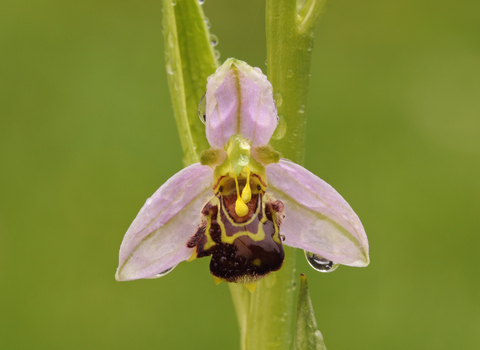
Bee orchid ©Dawn Monrose
Bee orchid
The bee orchid is a sneaky mimic - the flower’s velvety lip looks like a female bee. Males fly in to try to mate with it and end up pollinating the flower. Sadly, the right bee species doesn’t live here, so this orchid is self-pollinated in the UK.
Scientific name
Ophrys apiferaWhen to see
June to JulySpecies information
Category
Statistics
Height: up to 30cmProtected in Northern Ireland under the Wildlife Order, 1985.
Habitats
About
The bee orchid gets its name from its main pollinator - a species of bee - which is thought to have driven the evolution of the flowers. To attract the bees that will pollinate the plant, it has flowers that mimic their appearance. Drawing them in with the promise of love, the bees attempt a mating. As they land on the velvet-textured lip of the flower, the pollen is transferred and the poor bee is left frustrated. Sadly, the right species of bee doesn't occur in the UK, so bee orchids are self-pollinated here. Look out for their diminutive flower spikes on dry, chalk and limestone grasslands from June to July.How to identify
A small orchid, the bee orchid has a rosette of leaves at ground level and two leaves that grow up the stem as a sheath. The stem displays a number of relatively large flowers with pink sepals that look like wings, and furry, brown lips that have yellow markings on, just like a bee.Distribution
Found throughout the UK, but scarcer in the north.In our area
We don't have to look far to find bee orchids in London. Orchids are opportunistic, popping up in the newest habitats until they are outcompeted by grasses and brambles. Rarely trodden roadside verges are a clear favourite. London Wildlife Trust has been working hard to create optimum bee orchid habitats at:
- Chapel Bank - spot them in the short grass that runs atop the pipeline through the middle of the reserve
- Saltbox Hill - look for them scattered around the top of the hill.
Did you know?
The bee orchid is the county flower of Bedfordshire.We don't have to look far to find bee orchids in London. Orchids are opportunistic, popping up in the newest habitats until they are outcompeted by grasses and brambles. Rarely trodden roadside verges are a clear favourite. London Wildlife Trust has been working hard to create optimum bee orchid habitats at:
- Chapel Bank - spot them in the short grass that runs atop the pipeline through the middle of the reserve
- Saltbox Hill - look for them scattered around the top of the hill.
